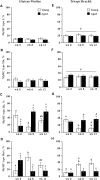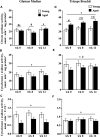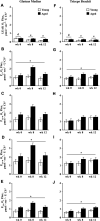Skeletal Muscle Adaptations to Exercise Training in Young and Aged Horses
- PMID: 35822026
- PMCID: PMC9261331
- DOI: 10.3389/fragi.2021.708918
Skeletal Muscle Adaptations to Exercise Training in Young and Aged Horses
Abstract
In aged humans, low-intensity exercise increases mitochondrial density, function and oxidative capacity, decreases the prevalence of hybrid fibers, and increases lean muscle mass, but these adaptations have not been studied in aged horses. Effects of age and exercise training on muscle fiber type and size, satellite cell abundance, and mitochondrial volume density (citrate synthase activity; CS), function (cytochrome c oxidase activity; CCO), and integrative (per mg tissue) and intrinsic (per unit CS) oxidative capacities were evaluated in skeletal muscle from aged (n = 9; 22 ± 5 yr) and yearling (n = 8; 9.7 ± 0.7 mo) horses. Muscle was collected from the gluteus medius (GM) and triceps brachii at wk 0, 8, and 12 of exercise training. Data were analyzed using linear models with age, training, muscle, and all interactions as fixed effects. At wk 0, aged horses exhibited a lower percentage of type IIx (p = 0.0006) and greater percentage of hybrid IIa/x fibers (p = 0.002) in the GM, less satellite cells per type II fiber (p = 0.03), lesser integrative and intrinsic (p 0.04) CCO activities, lesser integrative oxidative phosphorylation capacity with complex I (PCI; p = 0.02) and maximal electron transfer system capacity (ECI+II; p = 0.06), and greater intrinsic PCI, ECI+II, and electron transfer system capacity with complex II (ECII; p 0.05) than young horses. The percentage of type IIx fibers increased (p < 0.0001) and of type IIa/x fibers decreased (p = 0.001) in the GM, and the number of satellite cells per type II fiber increased (p = 0.0006) in aged horses following exercise training. Conversely, the percentage of type IIa/x fibers increased (p ≤ 0.01) and of type IIx fibers decreased (p ≤ 0.002) in young horses. Integrative maximal oxidative capacity (p ≤ 0.02), ECI+II (p ≤ 0.07), and ECII (p = 0.0003) increased for both age groups from wk 0 to 12. Following exercise training, aged horses had a greater percentage of IIx (p ≤ 0.002) and lesser percentage of IIa/x fibers (p ≤ 0.07), and more satellite cells per type II fiber (p = 0.08) than young horses, but sustained lesser integrative and intrinsic CCO activities (p 0.04) and greater intrinsic PCI, ECI+II, and ECII (p 0.05). Exercise improved mitochondrial measures in young and aged horses; however, aged horses showed impaired mitochondrial function and differences in adaptation to exercise training.
Keywords: aging; exercise; fiber type; horse; mitochondria; satellite cell.
Copyright © 2021 Latham, Owen, Dickson, Guy and White-Springer.
Conflict of interest statement
The authors declare that the research was conducted in the absence of any commercial or financial relationships that could be construed as a potential conflict of interest.
Figures







Similar articles
-
Rapid Communication: Differential skeletal muscle mitochondrial characteristics of weanling racing-bred horses.J Anim Sci. 2019 Jun 17;97(8):3193-8. doi: 10.1093/jas/skz203. Online ahead of print. J Anim Sci. 2019. PMID: 31211376 Free PMC article.
-
Effects of aging on mitochondrial function in skeletal muscle of American American Quarter Horses.J Appl Physiol (1985). 2016 Jul 1;121(1):299-311. doi: 10.1152/japplphysiol.01077.2015. Epub 2016 Jun 9. J Appl Physiol (1985). 2016. PMID: 27283918 Free PMC article.
-
RAPID COMMUNICATION: Differential skeletal muscle mitochondrial characteristics of weanling racing-bred horses1.J Anim Sci. 2019 Jul 3:skz203. doi: 10.1093/jas/skz203. Online ahead of print. J Anim Sci. 2019. PMID: 31270533
-
Muscle mechanics: adaptations with exercise-training.Exerc Sport Sci Rev. 1996;24:427-73. Exerc Sport Sci Rev. 1996. PMID: 8744258 Review.
-
The effects of endurance, strength, and power training on muscle fiber type shifting.J Strength Cond Res. 2012 Jun;26(6):1724-9. doi: 10.1519/JSC.0b013e318234eb6f. J Strength Cond Res. 2012. PMID: 21912291 Review.
Cited by
-
Impact of Coenzyme Q10 Supplementation on Skeletal Muscle Respiration, Antioxidants, and the Muscle Proteome in Thoroughbred Horses.Antioxidants (Basel). 2023 Jan 24;12(2):263. doi: 10.3390/antiox12020263. Antioxidants (Basel). 2023. PMID: 36829821 Free PMC article.
-
Effects of Treadmill Running at Different Light Cycles in Mice with Metabolic Disorders.Int J Mol Sci. 2023 Oct 13;24(20):15132. doi: 10.3390/ijms242015132. Int J Mol Sci. 2023. PMID: 37894813 Free PMC article.
-
Metabolomics analysis and mRNA/miRNA profiling reveal potential cardiac regulatory mechanisms in Yili racehorses under different training regimens.PLoS One. 2025 Jul 14;20(7):e0322468. doi: 10.1371/journal.pone.0322468. eCollection 2025. PLoS One. 2025. PMID: 40658689 Free PMC article.
-
Morphometric Measurements and Muscle Atrophy Scoring as a Tool to Predict Body Weight and Condition of Horses.Vet Sci. 2023 Aug 9;10(8):515. doi: 10.3390/vetsci10080515. Vet Sci. 2023. PMID: 37624301 Free PMC article.
-
Salivary biglycan-neo-epitope-BGN262: A novel surrogate biomarker for equine osteoarthritic sub-chondral bone sclerosis and to monitor the effect of short-term training and surface arena.Osteoarthr Cartil Open. 2023 Mar 15;5(2):100354. doi: 10.1016/j.ocarto.2023.100354. eCollection 2023 Jun. Osteoarthr Cartil Open. 2023. PMID: 36968250 Free PMC article.
References
-
- Barrey E., Valette J. P., Jouglin M. (1998). Analyse de la composition en chaînes lourdes de myosine chez le cheval : application la sélection du cheval de course. INRA Prod. Anim. 11, 160–163. 10.20870/productions-animales.1998.11.2.3933 - DOI
-
- Bechtel P., Kline K. (1987). “Muscle Fiber Type Changes in the Middle Gluteal of Quarter and Standardbred Horses from Birth through One Year of Age,” in Proc. Int. Conf. Equine Exer. Phys., San Diego, CA, August 7–11, 1986 (Davis, CA: ICEEP Publications, 1987; ), 265–270.
LinkOut - more resources
Full Text Sources
Miscellaneous

